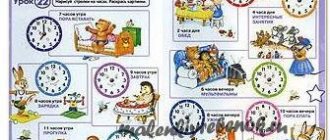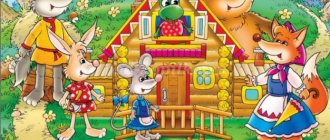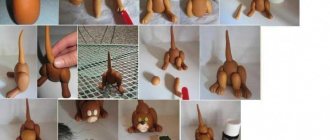Summary of theatrical activities in the senior group. "Who said "meow"
Transcript
1 Summary of theatrical activities in the senior group. “Who said “meow” Educator: Olga Fedorovna Vyatkina Goal: to create conditions for the development of children’s creative activity in theatrical activities. Objectives: educational - continue to teach children to transform into fairy-tale characters in the game. Developmental - develop the ability to build a line of behavior in a role, using attributes and costume details. Develop children's artistic abilities, the ability to improvise through facial expressions, expressive movements, and intonation. Educational to cultivate friendly relationships, feelings of empathy. Integration of educational areas Cognition: the formation of a holistic picture of the world, expanding the horizons of children. Socialization: development of children’s play activities, introduction to basic generally accepted norms and rules of relationships with peers and adults. Communication: development of free communication with adults and children, development of all components of oral speech, practical mastery of speech norms. Reading fiction: development of literary speech, introduction to verbal art, including the development of artistic education and aesthetic taste. Artistic creativity: development of children's productive activities, development of children's creativity, introduction to the fine arts. Preliminary work: finger games, reading fiction, d.i. “Live telephone”, “Transfers”, etudes “Transformation”, “Guess what I’m doing”, memorizing poems, tongue twisters, reading poetry by role, using different types of theater, exercises for the tongue, games for the development of imagination “Continue the fairy tale” Equipment for performance: masks-caps, screen-house, model of a flower, flowers for reflection with painted sad and cheerful faces, screen-costume Musical accompaniment. Progress: - Children, together with the teacher, enter the hall
2 Guys, we came to the music room of our garden. Here fairy tales come to life on stage. And fairy tales involve different heroes. Who plays the roles of these heroes? (Artists) Today you and I will also be artists and play different roles. What does an artist need to do to be like the hero of a fairy tale? That's right: wear a suit. Let's go to our costume room and turn into fairy tale heroes. Put on these masks and let's show our viewers the fairy tale "Who Said Meow?" Characters: Presenter, Puppy, Cat, Dog (Mom), Rooster, Frog, Bee. (In the center of the hall there is a house with a window. There is a rug on the floor near the house.) Presenter: Lived in the house was a cheerful, mischievous puppy. He could play with you and me. He barked very loudly, didn’t miss him at all, and didn’t upset his dear mother at all. (The Puppy appears with his mother) Woof, woof, woof! Let's play together having fun. Run together, jump together. Who will start? (Puppy dance with mom). Ved: Our Puppy was very cheerful, very lively, very fast, but tired. And so, yawning, he lay down to sleep on the carpet.
3 (Mom puts the Puppy to bed. He curls up on the rug near the house. The Cat runs in and sneaks up on the Puppy). Cat: I went to bed without dinner. I’ll wake up my neighbor. Wait a minute, my dear, I’ll make a joke on you Meow-meow! (runs away). (wakes up) Meow! who said it now? Who didn't let the puppy sleep? Ved: The puppy looked into the yard, He saw: Petya the Cockerel. In brand new red boots, he teaches everyone to play the spoons. Cockerel: Ko-ko-ko, Ku-ka-re-ku! I can teach everyone. (Playing on spoons). Meow! Did you just say? Didn't you let the puppy sleep? Cockerel: I shout: Ku-ka-re-ku! I can't do it any other way. (Leaves). Ved: The puppy is completely sad. He wants to find out quickly. Who's meowing! says, And runs away.
4 (The puppy jumps out into the yard through the window. The Cat looks out behind him, meows, and hides. Meow is heard) Meow! who said it now? Who didn't let the puppy sleep? Frog: I am a green belly, Bug-Eyed Frog. To everyone who asks without difficulty, I answer: Kva-kva-kva! (runs away). Host: Suddenly he hears Meow again! He sees a flower in the garden, A puppy approaches the flower, sticks his nose in, and runs away. Meow! who said it now? Bee: J-J-J. A chewier dog, take care of your poor nose. Well, well, you won’t bother in vain, Know that you can’t rush at the bees. (Stings the puppy on the nose). (The puppy closes its nose and runs around the house). Ay, how my nose hurts, Ay-yay-yy, how it burns! Now I’m the most unhappy one, I’ll call my mother for help. Mom knows everything in the world, and will answer my question. Mother! Mother! Mother:
5 What, son? I lay down to sleep for an hour, Someone said loudly to me: Meow! — immediately ran away. Mom: Look at the window, who is sitting there, do you see? Puppy Cat. Mom: The cat says meow, and she also purrs. Cat: Mur-mur, meow. (The cat approaches the Puppy) My mother suggested, It was You who said Meow!. Cat: And today the two of us will sing a song together. (Sing a song) All together: Mothers help their children, Mothers protect them, Mothers teach all children, both big and small.
6 The children bow. The teacher introduces the artists to the guests. Reflection: You did well today. Did you enjoy playing on stage? And in memory of our wonderful performance, I want to give you these flowers. And I hope that someday you will truly be good artists. (I offer flowers with painted sad and happy faces.) Self-analysis on theatrical activities “Who said “meow”” Educator: Vyatkina O. F. Equipment used in theatrical activities: a screen, a model of a flower, cap masks, flowers with painted faces (sad and cheerful). The play “Who Said Meow” was performed in accordance with the age characteristics of the children. Program objectives have an educational, educational and developmental orientation. For example, an educational task includes the task of teaching children to transform into fairy-tale characters, an educational task includes the task of nurturing friendly relationships, feelings of empathy, and a developmental task includes the task of developing children’s artistic abilities. The use of equipment contributed to the development of children's creative abilities. The children's interest was maintained throughout the entire performance. During theatrical activities with children, playful, verbal, visual and practical methods were used, which corresponded to the implementation of the goal of this activity. The leading methods in the development of children's creative activity were play dramatization, visual methods - the use of didactic aids, watching dramatizations, practical dramatization and verbal methods - memorization, storytelling. Thus, the planned amount of content has been fulfilled. The overall result of the theatrical activities contributed to the fulfillment of the planned amount of work with children. The goal of the theatrical activity has been achieved.
Summary of children's leisure activities using a tabletop theater in the senior group
Fly, Cluttering Fly Gilded belly. The fly walked across the field, the fly found the money. The Fly sat down on a tree stump and began to daydream a little... The Fly.
What should I buy?
Maybe the car is cool? Dress, shoes and jacket... And I’ll buy some candy! Author. Here an ant crawls out of the grass towards the fly. (Ant doll appears) Ant.
Eh, you Tsokotuha Fly!
Gilded belly. You wanted a lot of unnecessary things! Educator.
Children, the ant turned out to be right.
Do you think it’s possible to want everything at once? (children's answers) Educator.
Every person has needs.
This is something that is necessary and cannot be avoided. The important needs for life are the “need” needs, and the ones we need to strive for are the “want” needs. You must be able to choose what you need most. Let’s help Mucha figure out what is important to purchase first, and what can be purchased later. Didactic game “I want, I need” Educator.
You and I will split into two teams.
One team will choose what is needed first, and the other team will choose what they want, but not very important, which they can do without. All pictures must be attached to the easel. (children attach subject pictures corresponding to the task to magnetic boards) Educator.
Thank you for helping Mukha understand her desires, correctly identifying the most important needs and what to strive for.
What about our Fly? Fly.
What should I do?
What do i do? How can Mukha continue to live? Ant.
Fly, Fly-Tsokotukha!
You don’t need to walk around the field every day, but start earning money with your labor! Author.
The Ant left to do his important business... And the Fly began to argue, Where to get money.
So as not to walk across the field, but to get a penny. (The ant leaves the bundle and leaves) Educator.
Tell me how to make money?
(children's answers) Educator.
What is the name of the main business that a person studied and then began to work?
(children's answers) Educator.
That's right, profession.
Let's tell Mukha what professions there are. Didactic game “Name the profession”
(The teacher draws the children’s attention to the knot. Unties the knot, finds objects of labor in it. Invites the children to correlate the tools with the profession to which they belong.)
Author.
Our clever little fly accepted all the advice.
We know how the Tsokotukha Fly loved to greet guests. She decided to open a forest cafe, where everyone will meet. I found craftsmen, found a clearing, and built a cafe there. Educator.
Let's help Mukha-Tsokotukha build a cafe.
Physical exercise “Builders”
1, 2, 3, 4, 5 Hands on the belt, turns right, left.
We are building a big, tall house! We stand on our tiptoes, stretch our arms up, install windows, and build a roof. “Draw” the window, show the roof. What a beautiful house! We show the gesture “class!” Mucha will be comfortable in it! Let's clap our hands. Educator.
Now we will go to the store to buy the necessary goods for the cafe.
What do we need in order to buy a product? (children’s answers) Didactic game “Buying goods”
On the counter there are dummies of vegetables, fruits, packages of milk, bread and other products. There are also various items - toys, pencils, artificial flowers, etc. All goods have price tags with a catchy designation (circles of the same color) of the price. Each child receives a wallet containing 5 coins. Children's task: - count how many coins: - select and buy the right product for the cafe and explain your choice; - count how many coins are left; -decide what else you can buy with the remaining coins. Children put all purchased goods in a basket.







